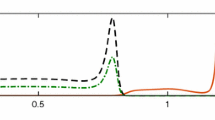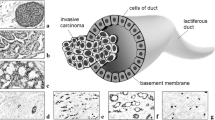Abstract
Current biological knowledge supports the existence of a secondary group of cancer cells within the body of the tumour that exhibits stem cell-like properties. These cells are termed cancer stem cells, and as opposed to themore usual differentiated cancer cells, they exhibit highermotility, they are more resilient to therapy, and are able to metastasize to secondary locations within the organism and produce new tumours. The origin of the cancer stem cells is not completely clear; they seem to stem from the differentiated cancer cells via a transition process related to the epithelial-mesenchymal transition that can also be found in normal tissue. In the current work we model and numerically study the transition between these two types of cancer cells, and the resulting “ensemble” invasion of the extracellular matrix. This leads to the derivation and numerical simulation of two systems: an algebraic-elliptic system for the transition and an advection-reaction-diffusion system of Keller-Segel taxis type for the invasion.
Similar content being viewed by others
References
V. Andasari, A. Gerisch, G. Lolas, A.P. South and M.A.J. Chaplain. Mathematical modelling of cancer cell invasion of tissue: biological insight from mathematical analysis and computational simulation. J. Math. Biol., (2011).
A.R.A. Anderson, M.A.J. Chaplain, E.L. Newman, R.J.C. Steele and A.M. Thompson. Mathematical modelling of tumour invasion and metastasis. Comput. Math. Method., (2000).
P. Armitage and R. Doll. The age distribution of cancer and a multi-stage theory of carcinogenesis. Br. J. Cancer, (1954).
T. Brabletz, A. Jung, S. Spaderna, F. Hlubek and T. Kirchner. Opinion: migrating cancer stem cellsan integrated concept ofmalignant tumour progression. Nature Reviews Cancer, (2005).
M.A.J. Chaplain and G. Lolas. Mathematical modelling of cancer cell invasion of tissue. the role of the urokinase plasminogen activation system. Math. Models Methods Appl. Sciences, (2005).
A. Chertock and A. Kurganov. Asecond-order positivity preserving central-upwind scheme for chemotaxis and haptotaxis models. Numerische Mathematik, (2008).
P. Domschke, D. Trucu, A. Gerisch and M. Chaplain. Mathematical modelling of cancer invasion: Implications of cell adhesion variability for tumour infiltrative growth patterns. J. Theor. Biology, 361 (2014), 41–60.
J.C. Fisher. Multiple-mutation theory of carcinogenesis. Nature, (1958).
R. Ganguly and I.K. Puri. Mathematicalmodel for the cancer stem cell hypothesis. Cell Prolif, (2006).
D. Gao, L.T. Vahdat, S. Wong. Microenvironmental regulation of epithelial-mesenchymal transitions in cancer. Cancer Res., (2012).
A. Gerisch and M.A.J. Chaplain. Mathematical modelling of cancer cell invasion of tissue: local and nonlocal models and the effect of adhesion. J. Theor. Biol., (2008).
P.B. Gupta, C.L. Chaffer and R.A. Weinberg. Cancer stem cells: mirage or reality? Nat. Med., (2009).
M.D. Johnston, P.K. Maini, S. Jonathan-Chapman, C.M. Edwards and W.F. Bodmer. On the proportion of cancer stem cells in a tumour. J. Theor. Biology, (2010).
Y. Katsumo, S. Lamouille and R. Derynck. Tgf-β signaling and epithelialmesenchymal transition in cancer progression. Curr. Opin. Oncol., (2013).
E.F. Keller and L.A. Segel. Initiation of slime mold aggregation viewed as an instability. J. Theoret. Biol., (1970).
N. Kolbe. Mathematicalmodelling and numerical simulations of cancer invasion. Master’s thesis, University of Mainz, supervised by M. Lukacova-Medvidova, and N. Sfakianakis, (2013).
N. Kolbe, J. Katuchova, N. Sfakianakis, N. Hellmann and M. Lukacova-Medvidova. A study on time discretization and adaptive mesh refinement methods for the simulation of cancer invasion: The urokinase model. Appl. Math. Comput., (2015).
A. Kurganov and M. Lukacova-Medvidova. Numerical study of two-species chemotaxis models. Discr. Cont. Systems, (2014).
S.A. Mani, W. Guo, M.J. Liao. The epithelial-mesenchymal transition generates cells with properties of stem cells. Cell, (2008).
S.R McDougall, A. Anderson, M.A.J. Chaplain and J.A. Sheratt. Mathematical modelling of flow through vascular networks: Implications for tumour-induced angiogenesis and chemotherapy strategies. Bull. Math. Biol., (2002).
F. Michor. Mathematical models of cancer stem cells. J. Clin. Oncol., (2008).
A. Neagu, V. Mironov, I. Kosztin, B. Barz, M. Neagu, R.A. Moreno-Rodriguez, R.R. Markwald and G. Forgacs. Computational modelling of epithelial-mesenchymal transformations. Biosystems, (2010).
C.O. Nordling. A new theory on the cancer-inducing mechanism. Br. J. Cancer, (1953).
A.J. Perumpanani, J.A. Sherratt, J. Norbury and H.M. Byrne. Biological inferences from a mathematical model for malignant invasion. Invasion Metastasis, (1996).
L. Preziosi. Cancer modelling and simulation. CRC Press, (2003).
D.C. Radisky. Epithelial-mesenchymal transition. J. of Cell Science, (2005).
T. Reya, S.J. Morrison, M.F. Clarke and I.L. Weissman. Stem cells, cancer, and cancer stem cells. Nature, (2001).
K. Shien, S. Toyooka, H. Yamamoto. Acquired resistance to egfr inhibitors is associated with a manifestation of stem cell-like properties in cancer cells. Cancer Res., (2013).
A. Singh and J. Settleman. Emt, cancer stemcells and drug resistance: an emerging axis of evil in the war on cancer. Oncogene, (2010).
T. Stiehl and A. Marciniak-Czochra. Mathematical modeling of leukemogenesis and cancer stem cell dynamics. Math. Mod. Nat. Phen., (2012).
J.P. Thiery. Epithelial-mesenchymal transitions in tumour progression. Nature Reviews Cancer, (2002).
V. Vainstein, O.U. Kirnasovsky and Y.K. Zvia Agur. Strategies for cancer stem cell elimination: Insights from mathematical modelling. J. Theor. Biology, (2012).
D.C. Voon, H. Wang, J.K. Koo. Emt-induced stemness and tumorigenicity are fueled by the egfr/ras pathway. PLoS One, (2013).
X. Zhu, X. Zhou, M.T. Lewis, L. Xia and S. Wong. Cancer stem cell, niche and egfr decide tumor development and treatment response: A bio-computational simulation study. J. Theor. Biol., (2011).
Author information
Authors and Affiliations
Corresponding author
About this article
Cite this article
Hellmann, N., Kolbe, N. & Sfakianakis, N. A mathematical insight in the epithelial-mesenchymal-like transition in cancer cells and its effect in the invasion of the extracellular matrix. Bull Braz Math Soc, New Series 47, 397–412 (2016). https://doi.org/10.1007/s00574-016-0147-9
Received:
Published:
Issue Date:
DOI: https://doi.org/10.1007/s00574-016-0147-9




